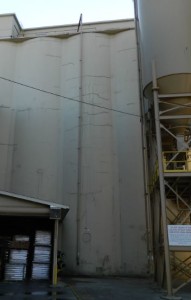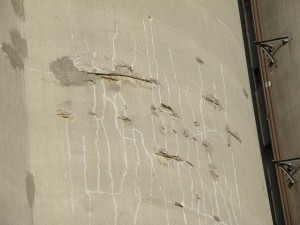The purpose of this article is to discuss concrete fracturing. What is it, and what are the causes? What do you need to be looking for, and how can the issues be taken care of? When it comes to concrete fracturing, there are many signs to be on the lookout for in order to prevent an increased risk of rebar corrosion and premature concrete damage.
What is concrete fracturing?
A concrete fracture occurs when there is cracking in the concrete, indicating that there is some type of stress or deterioration within. Although concrete fractures are very common, they are not supposed to happen and oftentimes are indicators of further underlying issues. If a fracture forms, it is the result of an underlying force that will continue if left untreated. Once a fracture forms, further deterioration will continue to occur.
What causes fracturing?
The forces of nature and man. Most deterioration that occurs within concrete is due to improper construction, improper use, excessive use, settlement, and weather.
Improper Construction:
-The placement of the rebar is too close to the surface, meaning there is not enough concrete cover. With a cover-to-bar diameter ratio of 7, concrete cracking starts when corrosion reaches 4 percent, whereas with a cover-to-bar diameter ratio of 3, only 1 percent corrosion is enough to crack the concrete.
-Inconsistent rebar spacing.
-Improper rebar spacing.
-Rebar lap splices are not staggered vertically.
-Inadequate length of lap splice overlaps.
Stresses from Use: There are different types of stress that come from structural forces. Because the tensile strength of concrete is only about 10 percent of the compressive strength, even small tensile stresses associated with shrinkage and loads can crack concrete.
Tension: To understand tension, think of trying to snap a hard cookie in half; the harder the cookie, the harder the tensional strength is on the top of the cookie.
Compression: To understand compression, think of the cracks on the top of your shoe; the cracks that are formed from it being compressed or pushed together. It can be concluded that in compressive members, cracking and spalling of concrete reduces the effective cross-section of the concrete, thereby reducing the ultimate compressive load capacity.
Shear: To understand this stress, think of poking a pencil through paper. The tear that it causes is due to the shear stress, which is why they call scissors “shear scissors.”
Corrosion of Rebar: As rebar corrodes, or rusts, it expands with great force and often causes fractures. Common causes of rebar corrosion are as follows:
Moisture Induced: This type of corrosion comes from moisture laden concrete which coupled with mild steel reinforcing creates an environment whereas electrical currents occur, known as electrolysis, which affects steel reinforcing.
Carbonation Induced: This occurs when carbon dioxide in the air migrates into the concrete where it reacts with calcium hydroxide in the concrete, thus lowering the alkalinity beyond the passive state. Consequently, the concrete protection of the reinforcing steel is lost, making it susceptible to corrosion.
Chemical Induced: Typically seen on sidewalks or near grade, chemicals such as chloride from de-icing salts can be introduced from the surface and can act as a catalyst in the corrosion process.
What do you need to look for?
-Are they vertical or horizontal? Column/beam shear cracking at connections can be caused by horizontal movement. Horizontal forces can accumulate from volume changes caused by temperature changes, elastic shortening caused by post-tension forces, or foundation movements caused by settlement or earthquakes.
-Are they on slabs or spans of concrete? Column connections to slabs and beams experience considerable shear stress. Excessive stress produces cracks in the beams and in the surrounding slabs.
-Is there rebar or rust showing?
-Is concrete breaking off?
-How wide are the cracks? Depending on the width of the crack where it intersects the steel, longitudinal cracks may promote corrosion of the steel reinforcement.
-Are the cracks in a normal pattern or are they random?
-How close are the cracks? Are they concentrated to one area? Cracks may develop, forming hinges at three possible locations: the crown (top of the pipe), and at the two spring line locations (sides of the pipe).
For more information about concrete fracturing, please contact Trisco Systems, Inc. at 419-339-3906.
Source information. “Concrete Behavior”. Concrete Repair and Maintenance, Peter H. Emmons.
http://www.amazon.com/Concrete-Repair-Maintenance-Illustrated-Techniques/dp/0876292864

